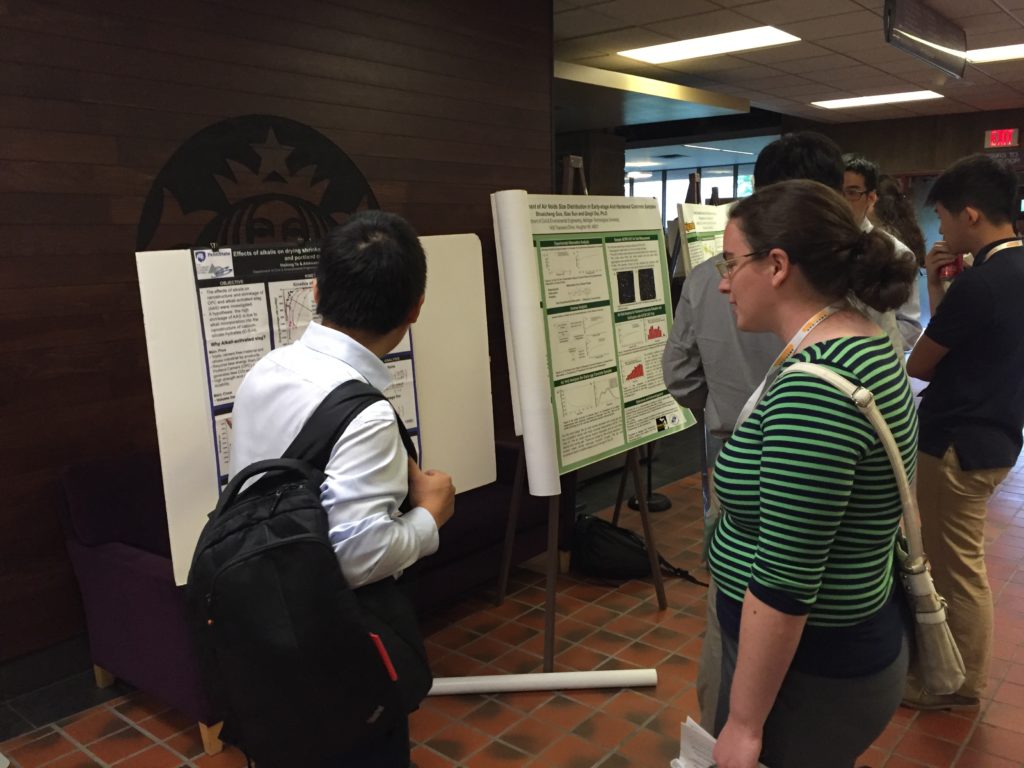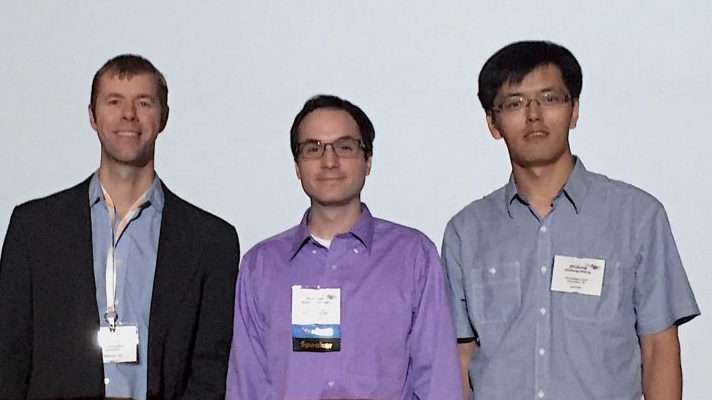
[Image above] Conference attendees exchange information about their latest research during the poster session at the 7th Advances in Cement-Based Materials conference in Evanston, Ill. Credit: ACerS
[Editor’s note] This story was written by Tricia Freshour, ACerS membership services manager; and Kevin Thompson, ACerS director of membership. Both attended the 7th Advances in Cement-Based Materials conference in Evanston, Ill.
ACerS Cements Division held a successful meeting July 10–13 at Northwestern University in Evanston, Ill. The 7th Advances in Cement-Based Materials conference brought together 113 academics, students, and cements professionals from around the globe.
The three-day event kicked off with a poster session and reception on July 10 that featured more than 30 poster presentations. Poster winners included Matthew Krafcik, Purdue University; Ardavan Ardeshirilajimi, University of Illinois at Urbana-Champaign; and Zhidong Zhang, Princeton University.

Tyler Ley (left), Cements Division Chair, poses for a picture with two of the winners of the student poster competition. Matthew Krafcik (center), Purdue University, won for his poster “Superabsorbent hydrogels as internal curing agents: Investigating the effects of hydrogel particle size on properties and microstructure of concrete.” Zhidong Zhang (right), Princeton University, won for his poster “Comparison of different methods to dry OPC paste.” Credit: ACerS
A new YouTube video contest was also held prior to the conference to promote the ACerS Cements Division meeting and its research activities. Winners included Elizaveta Pustovgar from ETH Zurich for her video “Understanding silicate hydration from quantitative analyses of hydrating C3S”; and Yu Song from the University of Illinois at Urbana-Champaign for his video “Mechanical behavior of foam concrete.”

Ley (left) pictured with the winners of the YouTube video contest, Elizaveta Pustovgar (center) and Yu Song (right). Credit: ACerS
Technical sessions started the following day and featured the Cements Division Annual Business Meeting and the Della Roy Lecture and Reception, delivered by Joseph J. Biernacki from Tennessee Technological University.
Biernacki’s thought-provoking presentation, “What do artificial intelligence, synthetic life-chemistry and nuclear fusion have to do with cement? (A vision of things to come),” offered predictions for the future of the cements industry and factors affecting long-term research and development, including research instrumentation, global warming, cyber infrastructure, computational science, construction technology, mineral resources, population growth, energy production technology, and policy.
The Stephen Brunauer Award was also presented during the annual business meeting. The award is presented annually to the author(s) of the best refereed paper on cements published during the previous calendar year in the Bulletin or the Journal of the American Ceramic Society.
This year’s Brunauer Award was a two-part article titled “An application of computer-aided molecular design (CAMD) using the signature molecular descriptor. Identification of surface tension reducing agents and the search for shrinkage reducing admixtures,” (parts 1 and 2) published in the Journal of the American Ceramic Society. The authors included Hamed M. Kayello, Naresh K. R. Tadisina, Natalia Shlonimskaya, Joseph J. Biernacki, and Donald P. Visco Jr. (part 1); and Natalia Shlonimskaya, Joseph J. Biernacki, Hamed M. Kayello, and Donald P. Visco (part 2).
CTLGroup (Skokie, Ill.) hosted conference attendees at its campus on July 12 for a workshop on forensic engineering and tour of the labs that once served as the research branch of the Portland Cement Association—the labs where some of the most seminal research in cement and concrete was completed.
A symposium was held to honor Surendra Shah, professor at Northwestern University. The symposium, “Cement-based materials of the future,” featured talks on the future of concrete, industry trends, and innovations in concrete technology. The symposium concluded with a dinner to honor Shah to recognize his 50 years of teaching and myriad contributions to the industry.

Maria Juenger, University of Texas at Austin, delivers her presentation, “The future of concrete may be in its past: The natural pozzolan renaissance,” during the “Cements-based materials of the future” symposium. Credit: ACerS
Planning for next year’s meeting is underway, so stay tuned for details.
Were you at this year’s meeting? Share your favorite moments with us in the comments!
